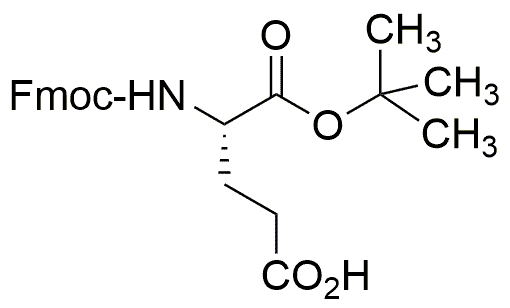Fmoc-L-glutamic acid a-tert-butyl ester is widely utilized in research focused on:
- Peptide Synthesis: This compound serves as a protecting group in the synthesis of peptides, allowing for the selective modification of amino acids without affecting others. This is crucial for creating complex peptides in pharmaceuticals.
- Drug Development: It plays a significant role in the development of new drugs, particularly in designing compounds that target specific biological pathways, enhancing the efficacy of therapeutic agents.
- Biotechnology: In the field of biotechnology, it is used to create modified proteins that can improve the stability and activity of enzymes, which are essential for various industrial processes.
- Research in Neuroscience: The compound is utilized in studies related to neurotransmitter pathways, particularly in understanding the role of glutamic acid in synaptic transmission, which is vital for developing treatments for neurological disorders.
- Analytical Chemistry: It is employed in analytical methods to separate and identify amino acids and peptides, providing researchers with valuable data for quality control in pharmaceutical manufacturing.
General Information
Properties
Safety and Regulations
Applications
Fmoc-L-glutamic acid a-tert-butyl ester is widely utilized in research focused on:
- Peptide Synthesis: This compound serves as a protecting group in the synthesis of peptides, allowing for the selective modification of amino acids without affecting others. This is crucial for creating complex peptides in pharmaceuticals.
- Drug Development: It plays a significant role in the development of new drugs, particularly in designing compounds that target specific biological pathways, enhancing the efficacy of therapeutic agents.
- Biotechnology: In the field of biotechnology, it is used to create modified proteins that can improve the stability and activity of enzymes, which are essential for various industrial processes.
- Research in Neuroscience: The compound is utilized in studies related to neurotransmitter pathways, particularly in understanding the role of glutamic acid in synaptic transmission, which is vital for developing treatments for neurological disorders.
- Analytical Chemistry: It is employed in analytical methods to separate and identify amino acids and peptides, providing researchers with valuable data for quality control in pharmaceutical manufacturing.
Documents
Safety Data Sheets (SDS)
The SDS provides comprehensive safety information on handling, storage, and disposal of the product.
Product Specification (PS)
The PS provides a comprehensive breakdown of the product’s properties, including chemical composition, physical state, purity, and storage requirements. It also details acceptable quality ranges and the product's intended applications.
Certificates of Analysis (COA)
Search for Certificates of Analysis (COA) by entering the products Lot Number. Lot and Batch Numbers can be found on a product’s label following the words ‘Lot’ or ‘Batch’.
Numéro de catalogue
Numéro de lot/série
Certificates Of Origin (COO)
This COO confirms the country where the product was manufactured, and also details the materials and components used in it and whether it is derived from natural, synthetic, or other specific sources. This certificate may be required for customs, trade, and regulatory compliance.
Numéro de catalogue
Numéro de lot/série
Safety Data Sheets (SDS)
The SDS provides comprehensive safety information on handling, storage, and disposal of the product.
DownloadProduct Specification (PS)
The PS provides a comprehensive breakdown of the product’s properties, including chemical composition, physical state, purity, and storage requirements. It also details acceptable quality ranges and the product's intended applications.
DownloadCertificates of Analysis (COA)
Search for Certificates of Analysis (COA) by entering the products Lot Number. Lot and Batch Numbers can be found on a product’s label following the words ‘Lot’ or ‘Batch’.
Numéro de catalogue
Numéro de lot/série
Certificates Of Origin (COO)
This COO confirms the country where the product was manufactured, and also details the materials and components used in it and whether it is derived from natural, synthetic, or other specific sources. This certificate may be required for customs, trade, and regulatory compliance.


